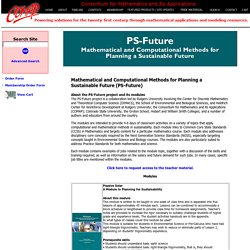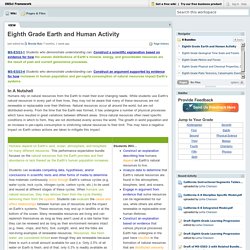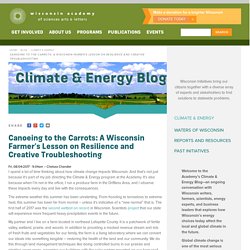

Geography, Climate, and Human Cities. The distribution of human populations and use of resources over time has been largely influenced by the Earth’s geography and climate.

At the same time, the decisions humans make about where to live and how they use the Earth’s resources has and will continue to have significant impact on the Earth’s climate and geography. In this unit, students will analyze and create topographic maps of human cities as they consider how geographical features such as oceans, lakes, and mountains have influenced where humans have chosen to live. Students will also make predictions about how changes in the Earth’s surface features that may take place—whether due to climate change or other factors—can influence the migration of human populations in the future.
Essential Questions: : PS-Future. Invasive Species A Module in Planning for Sustainability About This Module: This module focuses on the role of non-native species in ecosystems.

Students explore local examples of such species, including how and why these species become established in ecosystems. Then, after working through the concept of population growth and competitive exclusion, students work with a hands-on randomized simulation model to explore how the number of individuals of a nonnative (or an exotic) species population might influence the ability of that species to take hold and become invasive, doing damage to the ecosystem. A second deterministic model raises questions about how the spatial pattern of an invasion can impact the effectiveness of efforts to contain or slow invasive spread.
: BioMath. Quorum Sensing: Organisms Communicating and Coordinating We live in an ever-changing world.

Many people crave information about those changes. As a result, new means of communicating are continually evolving. People originally relied on word of mouth. With the invention of the printer, newspapers spread information to more people, more quickly. Later, telephones, television, cell phones and the Internet increased both the rate at which people could communicate and the number of people that the information reached.
Topics Biology: This unit discusses bacterial growth and communication. Prerequisites Biology: A basic understanding of cell structure and functions along with the Central Dogma would be helpful, but is not necessary. Length This unit consists of 5 lessons and will take 4-6 class periods (45 minutes each) if the majority of the work is done during class. Eighth Grade Earth and Human Activity. Humans depend on Earth’s land, ocean, atmosphere, and biosphere for many different resources.

This performance expectation bundle focuses on the natural resources that the Earth provides and their abundance or lack thereof as the Earth’s human population increases. Students can evaluate competing data, hypotheses, and/or conclusions in scientific texts and other forms of media to determine how materials continuously move through Earth’s various cycles (e.g. water cycle, rock cycle, nitrogen cycle, carbon cycle, etc.) to be used and reused at different stages of these cycles. When humans use natural resources, they may remove them from the cycle thereby removing them from the system. Ivan The Remarkable True Story of the Shopping Mall Gorilla. Canoeing to the Carrots: A Wisconsin Farmer’s Lesson on Resilience and Creative Troubleshooting. I spend a lot of time thinking about how climate change impacts Wisconsin.

And that’s not just because it’s part of my job directing the Climate & Energy program at the Academy. It’s also because when I’m not in the office, I run a produce farm in the Driftless Area, and I observe these impacts every day and live with the consequences. The extreme weather this summer has been unrelenting. From flooding to tornadoes to extreme heat, this summer has been far from normal – unless it’s indicative of a “new normal” that is. The first half of 2017 was the second wettest on record in Wisconsin. My partner and I live on a farm located in northeast Lafayette County. A view of our produce fields and barn from the prairie remnant. The Mud Branch of the Pecatonica River separates the farm buildings from the produce fields. This year, we ran out of luck. A different Thursday in late July proved much more challenging. Study of Place - eBooks.
Videos. Games. Fully Developed, Vetted Lessons. Interactives, Simulations, and Apps. Phenomena. Lesson Ideas.